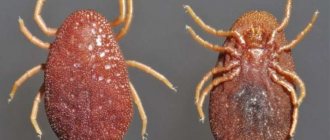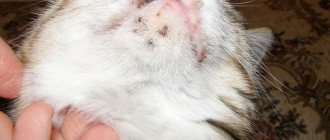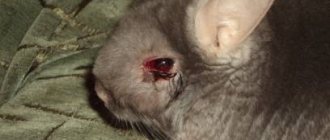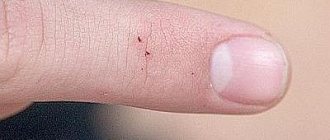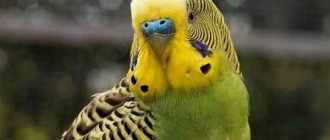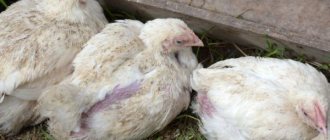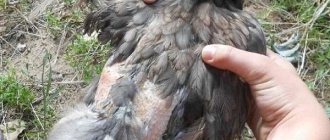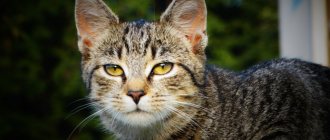Sources of infection
It is impossible to rule out infection of a bird from a tick bite. Veterinarians identify the following sources of infection:
- Poor living conditions, non-compliance with the rules of basic hygiene and nutrition, lack of care on the part of the owner.
- You can buy an already infected pet. The probability increases if there are many birds in the cage and among them there are sick ones.
- Grain mixture of low quality or expired, damaged by fungus and mold.
- New plaid accessories that have not been heat treated. Toys that have been used or donated by the owners of another parrot pose a high risk.
- The presence in the house of bouquets or compositions of tree branches and shrubs that may contain parasites.
- Contact with an infected parrot during mating.
- Exceptional cases include the “transportation” of ticks on the soles of shoes.
Prevention methods
To prevent the appearance of ticks and fluff eaters, the following measures can be taken:
- observe quarantine;
- wash and disinfect equipment in a timely manner;
- feed the birds well;
- buy high-quality grain mixtures;
- pour boiling water over branches, greens and fruits;
- Take your pets to the doctor regularly.
Budgerigars can have different types of mites: tracheal mites, feather mites, scabies and others. Pests cause serious damage to the health of feathered pets, but are not dangerous to humans. It is important to learn to recognize diseases in order to protect birds from serious consequences.
Classification of parasites
The danger of a tick is that it exists for a long time without noticeable symptoms. A single focus of itching will not bother the bird much, but after viral bodies enter its blood and its immunity decreases, the parasite will begin to multiply.
Types of parasites:
Scabies One of the common types of parasites, it settles in the upper layers of the parrot's skin. The principle of infection is that the produced toxins are placed in the bite area and the bird is infected.
Feathered Has a small flattened body. It eats away at the skin and drinks the blood and lymph that appears on the surface of the epidermis after the bird scratches or gnaws itself in the hope of getting rid of the itch.
Tracheal Lives in the internal respiratory organs, where it makes a nest. After laying the larvae, the female crawls into the upper respiratory tract, and the male continues to infect the lungs of the bird.
Syringophilosis The parasite settles at the edge. The parasite feeds on lymph and gradually infects new feathers. Actively breeding.
Knemidocoptic mange in parrots, treatment
Knemidocoptes mites are difficult to notice and their size does not exceed 0.4 mm. They feed on the epidermis of birds.
Ticks settle on parts of the parrot's body that are not protected by feathers - the wax, paws, cloaca, and in the area around the eyes. The parasite actively multiplies, creates numerous passages in the skin and causes unbearable itching, the skin becomes porous. This mite is called scabies because of the reaction of the victim: the parrot constantly itches and behaves restlessly.
Most often, a bird reaches its owner already infected from the previous owner if it was kept in unsuitable conditions and had contact with sick relatives. Ticks and their eggs can be carried into the cage along with food and tree branches.
The incubation period of the parasite lasts 4 months. During this period, the symptoms of the disease are practically invisible. If the bird's immune system is in order, knemidocoptosis will occur in a latent form without obvious signs of the disease, but the parrot will become a source of infection for its feathered neighbors.
Any stressful situation, lack of vitamins, poor nutrition and hypothermia will lead to the rapid development of severe lesions:
- feathers will fall out;
- large growths form on the skin;
- the beak will bend.
Only timely treatment of knemidotocoptosis in parrots can save the situation. If no measures are taken, the bird will die.
Symptoms and stages of the disease
When bitten by a scabies mite, there are several stages of a pet’s disease:
- Initial. There is no way to identify the parasite. There are no symptoms during the incubation period of 120 days.
- Easy. Itching initially appears on the paws and wax, growths appear from scratching, peeling and flaking begin, the parrot often scratches the bite site.
- Average. The parasite begins to infect the beak, eyelids and cloaca. After a bite, the beak begins to deform, and the bird stops eating, and feathers may fall out.
- Heavy. Global baldness is observed, there are scabs on the bald spots, the beak is crooked and bent to the side, the joints on the paws are inflamed. The pet stops eating and drinking, does not respond to sounds and external stimuli. The body is completely infected within six months. If you are not careful, the tissue of the bird’s internal organs and limbs will begin to die, after which it will die.
When infected with feather mites, a parrot will experience severe itching. He feels uncomfortable, sleeps poorly and becomes restless, his appetite worsens or disappears. As the disease develops, wounds and ulcers on the body do not heal, and in a humid and warm environment the number of mites increases. The pet's immunity weakens, feathers fall out, and weight decreases. This type of parasite exhibits maximum activity in the summer. Identifying a tick is simple - you need to warm the bird under a lamp for five to ten minutes. Ticks are heat-loving and will crawl to the surface.
The tracheal mite moves along the lining of the throat, thus causing a sore throat and the bird begins to cough. Some ticks are removed with saliva during coughing, while others are removed along with droppings. The first sign is a change in voice timbre or its absence. As the disease develops, the bird will have a constant cough, sneezing, and whistling in the chest area. Later, the pet begins to breathe with its beak, constantly opening it. Wounds will increase on the internal organs of the animal and foci of inflammation will appear; baldness of the head may be observed - feathers will partially or completely fall out. The bird will begin to refuse food, shortness of breath and loss of consciousness will appear. The final and worst stage of the disease is paralysis and death. Infection and disease are often asymptomatic, which increases the danger of tracheal parasites. The diagnosis can only be made by a veterinarian after testing the mucous membrane and droppings.
Syringophilosis settles in the flight and tail feathers, and inflammation of the epidermis begins. The incubation period is 90 days. The bird is losing weight and is depressed. Spots appear on the feathers. They become dull and fall out. The disease occurs in young pets with weak immune systems.
What types of ticks are there?
There are four main groups of mites that can infect budgies. Depending on the type of parasite, different symptoms appear.
| Type of ticks | Short description | Peculiarities |
| Feathers (pyroglyphoidosis) | The body of the parasite is flattened, elongated, yellow in color. Size – up to 0.2 cm. | They eat the feather, leaving bare shafts. They live only on the skin of a parrot. |
| Primary parasites (syringophilia) | They settle inside the feather shafts (fringes), causing them to darken. These parasites cause pathological molting (feather shedding) and itching. | They eat the skin and lymph of parrots. They form huge colonies. |
| Scabies mites (knemidocoptic mange) | Knemidocoptic mange in parrots may not be active for a long time, but under favorable conditions it can rapidly manifest itself. The sizes of parasites range from 0.03 to 0.05 cm. | They live, breed and move in the skin itself, as well as near the beak, eyes, paws, where peeling of the skin, scales, crusts, and growths are visually detected. They eat the skin of birds and liquid secretions from it. The incubation period of the disease when affected by scabies mites is up to 150-160 days, and during this time no signs of the disease may be observed. |
| Tracheal mites (sternostomosis) | The size of the tick is 0.01 - 0.06 cm. Claws are visible on the paws. When parasites move along the mucous membrane, parrots develop a reflex cough. These parasites live up to 20 days. | The most dangerous. They multiply uncontrollably. They feed on the skin of parrots and secretions from internal organs. Localized in the respiratory tract. When a bird sneezes, it scatters from its beak to the sides - onto equipment, food, or cage. |
Sources of parrot infection
The main sources that provoke the development of parasitic disease:
- Bad food (some food is packaged already infested with mites).
- All equipment that was brought from the street and was not disinfected before use.
- Placed infected chicks.
- Unsanitary conditions of detention.
Is the disease dangerous for humans?
Bird mites cannot live on the human body. If the parasite is transferred to human skin, the tick lives for a maximum of 2 days and dies. Therefore, we can say with confidence that the ticks that infect parrots are not dangerous to humans.
Treatment options
For the treatment of scabies mites, the most effective drug is birch tar. Apply a thin layer to the wounds. In advanced forms, doctors recommend lubricating the skin with Vaseline oil 2 times a day until recovery or Aversectin ointment for 5 days.
Important! Do not allow Aversectin ointment to come into contact with your eyes.
Cheaper medications are considered:
- Boric Vaseline - clogs the pores, leaves the parasite without oxygen, and it dies.
- Tar preparations.
One dose of the medicine is mixed with essential oil and spread on the epidermis. The tick will lack oxygen and die. On lubricated surfaces, the epidermis will become softer, scabs will be removed and new feathers will appear. Treatment should be carried out in courses - application of drugs once every 2 days for 3 weeks.
Not a single medicine affects the larvae, so the course is repeated once every 30 days after the parrot has recovered.
Treatment of feather mites is carried out with Arpalit, Celandine, Insectl. The release form of the drugs is repellent. You need to spray the medicine for 2 seconds from a distance of 20 cm very carefully to avoid poisoning your pet. Repeat the procedure after 7-8 days.
You can use traditional methods that are safe for birds:
- Rub ground wormwood powder into the feathers.
- Bathe your pet in chamomile decoction.
- Sprinkle feathers with sulfur powder.
Plant or sulfur powder can be rubbed in 3-4 times a day and repeated every week.
When a pet is infected with a tracheal mite, the following is prescribed:
- Ivermectin 0.2 mg/kg for 2-3 days, then a break. The drug kills only adult parasites. Apply to skin. 1 ml is diluted in a liter of water and the bird is fed for 4 days with a two-week interval.
- Permethrin and Imidacloprid are diluted 5:1. They eliminate parasites completely - from eggs to adults. Valid for 18 days. Carefully apply under the feather layer. They give expectorants to remove dead animals from the body.
Treatment for syringophilosis is carried out using Frontline or Otodectic with an active substance content of 0.1%. It is allowed to use an analogue of Ivermectin 0.1-0.12%. Apply to the withers and repeat after 3 weeks.
Feather mite in parrots
Feather mites are rare in parrots. More often they are diagnosed with the disease Syringophilia, caused by the mite; it prefers to settle in young feathers with a good blood supply. First, the tail feathers break off, then the feathers in the wings and on the back are destroyed.
The parasite is easy to detect if you examine the feathers under a microscope. You should start treating your parrot immediately as soon as ticks are detected. To do this, use a drug based on Ivermectin, lubricating the skin under the feathers on the back of the head.
Reasons for appearance
A tick can appear on a parrot for a number of reasons. But one of the contributing factors is weakened immunity caused by molting, non-compliance with care rules, and vitamin deficiency.
Common causes of mites in cockatiels and other parrot species:
- use of low-quality grain feed;
- cage accessories that have not undergone the necessary sanitary treatment;
- the use of non-disinfected branches;
- unsanitary conditions of detention;
- inclusion of fruits and vegetables in your pet’s diet without heat treatment;
- moving a new inhabitant into the poultry house who has not passed quarantine.
Can illness occur?
Even pet birds can be infested with different types of mites. They appear for various reasons, which include poor sanitation, poor quality food, or communication with infected individuals.
It is almost impossible to visually determine the presence of the disease, since the parasites are small in size. They feed on bird tissue and can also cause abnormalities in feathers or skin.
If, at the same time as ticks, the wavy suffers from other diseases or is not provided with proper care, then the parasites begin to multiply quickly. The bird itches a lot and plucks feathers, and can also become infected with various infectious diseases.
Preparations against scabies mites
Aversectin ointment is an effective tick repellent for parrots. This veterinary drug is aimed at eliminating damage caused by scabies mites and leads to the death of the parasites themselves. The ointment fights against insects that parasitize the bird’s body. Acts selectively, destroying the pest.
The place of settlement of the causative agent of knemidocoptosis is the layers of the epidermis. The parrot is accompanied by severe irritation and itching. In severe and advanced forms, not only the beak and paws are affected, but also the feathered areas.
For professional breeding of parrots
Those who breed budgerigars may also encounter the problem of fleas appearing in cages. In this case, it is necessary to treat the entire room. Due to the large number of birds, it is very resource-intensive to process each parrot manually. Therefore, in this case, we recommend considering treating the entire room with the Fomor Vet insecticidal smoke bomb.
Insecticidal bomb with cypermethrin “Fomor Vet”
The active ingredient is cypermethrin 5%, weight 50 g. The consumption rate of 50 g of the mixture is enough to treat a room from fleas to 70 cubic meters. Read more about this checker on the official website of the manufacturer Sanvetpreparat.
Preventing fleas
It is not enough to cure a patient through disinfection. It is necessary to take the necessary measures that can protect against possible relapses. Preventing an infection is much easier than looking for methods to eliminate it.
There are simple rules:
- Clean the cage regularly. Change bedding, wash equipment;
- wormwood is a proven folk method for fighting parasites. Its smell acts as a deterrent, preventing bloodsuckers from settling near it;
- If you want to buy a neighbor's bird, you need to temporarily quarantine the newcomer. This will help avoid infection;
- install a small tray of ash in the cage to prevent insect attacks;
- The drinking bowl and feeder must be in good condition at all times. It is important to regularly change food and water and wash containers with boiling water.
When carrying out regular cleaning, a person must wash not only the cage of a feathered pet, but also treat the room.
